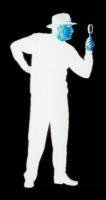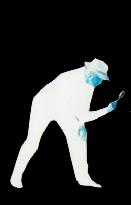|
 In 1932 disgusted by his treatment by the Dutch art critics, whom he believed to be incapable of appreciating his genius, he left Holland. He
wanted to prove that the critics were prejudiced and ignorant. His plan,
to paint a single picture that the world would accept as a Vermeer. In 1932 disgusted by his treatment by the Dutch art critics, whom he believed to be incapable of appreciating his genius, he left Holland. He
wanted to prove that the critics were prejudiced and ignorant. His plan,
to paint a single picture that the world would accept as a Vermeer.
 Van Meegeren's first forgery, and maybe his best, Christ at Emmaus,
was begun in 1936 and finished the following year. Its painting was preceded
by four years of research and experiments. Van Meegeren's first forgery, and maybe his best, Christ at Emmaus,
was begun in 1936 and finished the following year. Its painting was preceded
by four years of research and experiments.
 There were many problems to overcome. The first was artistic: to
paint in the artist's style. Other problems were technical: pigments,
media, brushes, and a canvas. Han practiced until he got the style and
paint mixtures right. Next came the canvas problem. He solved this
very easily. He would just purchase a 17th century painting by a
little known artist and strip it. He picked up a painting by Hendrik Hondius called Raising of Lazarus. There were many problems to overcome. The first was artistic: to
paint in the artist's style. Other problems were technical: pigments,
media, brushes, and a canvas. Han practiced until he got the style and
paint mixtures right. Next came the canvas problem. He solved this
very easily. He would just purchase a 17th century painting by a
little known artist and strip it. He picked up a painting by Hendrik Hondius called Raising of Lazarus.
 Now for the final part of the plan; to get the painting to look old
and pass the alcohol test. He would experiment by baking paintings at
various temperatures with different mixes of chemicals. After hundreds
of attempts one day he hit the right solution. He would use phenol and
formaldehyde in conjunction with lilac oil. He mixed the chemicals in one
container and the paint in another. When painting we would alternatively
dip his brush in the paint and then the chemicals. He then baked the
painting in an oven for different lengths of time. Then came the ultimate
test. He put alcohol on the painting and it did not fade or rub off.
The rest is history. Now for the final part of the plan; to get the painting to look old
and pass the alcohol test. He would experiment by baking paintings at
various temperatures with different mixes of chemicals. After hundreds
of attempts one day he hit the right solution. He would use phenol and
formaldehyde in conjunction with lilac oil. He mixed the chemicals in one
container and the paint in another. When painting we would alternatively
dip his brush in the paint and then the chemicals. He then baked the
painting in an oven for different lengths of time. Then came the ultimate
test. He put alcohol on the painting and it did not fade or rub off.
The rest is history. |







